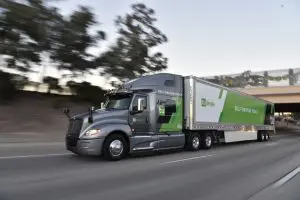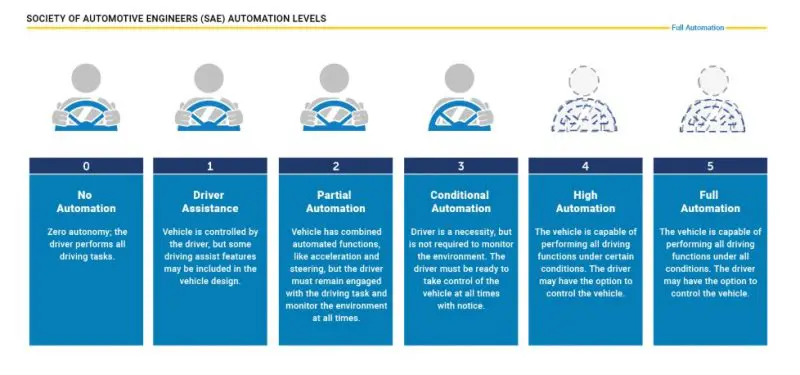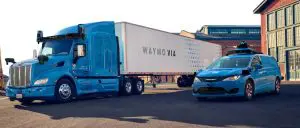Self-driving trucks: what does the future look like?
The (latest) future of self-driving trucks

Navistar and TuSimple have teamed up in the race to produce self-driving trucks (Image from TuSimple)
As autonomous vehicles are increasingly produced, a more daring venture on the horizon is the advent of self-driving trucks. News of these developments started several years ago – what progress has the industry made since then? And, what kind of impact could self-driving trucks have on road and driver safety, as well as potential legal ramifications?
Today, autonomous driving technology is one of the most discussed new developments on the horizon. Over the past five years, many companies have been developing self-driving technology both for cars and for long-haul trucks. Our truck accident lawyer takes a look at self-driving vehicles and what they could mean for the future of transit, road safety, traffic incidents and indeed the wider economy.
What is “autonomy”?
Before we go any further, it is important to demonstrate exactly what is meant by “autonomy.”
The industry has adopted the following levels of increasing technological complexity, established by the Society of Automotive Engineers (SAE International), called the J3016 Standard:
- Level 0 No Automation: the driver has complete control of the car
- Level 1 Driver Assistance: One function controlled automatically (adaptive cruise control, park assist features, etc.)
- Level 2 Partial Automation: Both steering and acceleration & deceleration are automated, with the driver able to take control of the vehicle
- Level 3 Conditional Automation: All safety-critical functions are automated, but the driver is present for certain traffic and environmental conditions
- Level 4 High Automation: Automated to perform all safety-critical functions and roadway conditions for a full trip (driver still present)
- Level 5 Full Automation: Expected to perform equal to a human driver, in all scenarios and conditions (driver not present)

These levels of complexity outline the possibilities for autonomous vehicles, including self-driving trucks
What has hampered development?
Indeed, autonomous vehicles (AV’s) have received a lot of press in the past five years, but as Vox wrote in a special report earlier in 2020, many of the projects have been reevaluated as companies realize the full scope of the undertaking. Tragedies have negatively impacted public perception and given the industry pause. After an Uber self-driving Volvo SUV in Arizona killed a jaywalking pedestrian in March 2018, an analysis found that the vehicle did not have the “capability to classify an object as a pedestrian unless that object was near a crosswalk.” This underscores one of the challenges with deep learning, explained recently by Toyota engineers:
“There are three different systems that you need in a self-driving car: It starts with perception, then goes to prediction, and then goes to planning. The one that by far is the most problematic is prediction. How do you predict what a human being is going to do? That’s difficult for deep learning to learn right now.” – Dr. Gill Pratt, CEO of Toyota Research Institute (TRI) (emphasis by Munley Law Personal Injury Attorneys)
In order for society to adopt AV technology, the artificial intelligence (AI) behind the vehicles must be so advanced that it is at least as safe as human drivers – if not safer. Statistics show that there is about one fatal accident per 100 million miles driven when humans are driving in the U.S. Waymo – the current market leader – has surpassed 20 million miles driven in its AV fleet. To be sure, they have also conducted over 15 billion miles of simulation testing, which will help strengthen research during this pandemic. But real world scenarios on public roads – like a jaywalking pedestrian or someone running a red light – will be the true test for AV technology.
Trucking’s turn at autonomous vehicles
Autonomous truck development faces similar AI challenges – albeit on a different scale. There was a lot of fanfare when Uber purchased Otto trucks in 2016, but they have since met legal and technical struggles – choosing to focus solely on self-driving cars in the near future (not ruling out self-driving trucks in the long-term).
One of Otto’s co-founders, Don Burnette has since founded Kodiak Robotics. Their team has taken a unique approach, developing trucks that can drive themselves “on highways between truckports”, stations next to highways or similar roads. At these ports, cargo can be transferred to a human-driven truck or a driver “can hop in one of Kodiak’s Kenworth T680s cabs.” Kodiak has actually found a silver lining to autonomous trucking – saying that “the technology fits better for trucks” as truck drivers do not face the same challenges on the highway as they do in cities that have more unpredictable pedestrian behavior.

Kodiak Robotics is one of the leading companies developing self-driving truck technology (Image from Kodiak)
Kodiak Robotics recently “filed a voluntary safety self-assessment” with the U.S. Department of Transportation (DOT), joining other autonomous trucking companies in TuSimple, Ike Robotics and now closed Starsky Robotics. (See Kodiak’s 2020 Safety Report). Of course, Munley Law Personal Injury Attorneys is keenly aware of safety concerns on the road as it relates to truck driving.

Waymo (part of Google parent Alphabet) is one of the star companies developing self-driving capabilities. (Image from Waymo)
Building on accomplishments in driverless truck technology
Another company, Plus.ai, received a lot of attention last year when one of its semi-autonomous trucks completed a three-day, 2,800-mile journey from California to Pennsylvania, transporting 40,000 pounds of butter for Land O’Lakes. This truck operated at Level 2 Partial Automation, as both a safety driver and safety engineer were in the cab – with the driver ready to take the wheel if needed.
These are not the only companies making strides. Just last month, San Diego-based Chinese-American TuSimple announced the “world’s first” Autonomous Freight Network (AFN), described as ““an ecosystem consisting of autonomous trucks, digital mapped routes, strategically placed terminals.” This is a new partnership established with UPS, Penske Truck Leasing, U.S. Xpress and McLane, a supply chain services company.

Self-driving trucks: TuSimple has launched the first Autonomous Freight Network (AFN) (Image from TuSimple)
TuSimple has also entered into a partnership with Navistar International to sell International-branded driverless trucks in 2024. Other companies such as Volvo Trucks Vera and Daimler have been heavily investing in autonomous technologies.
Cautiously optimistic
Undoubtedly, there is a lot of encouraging work happening across the industry. But MIT researchers published a brief last month that has helped tone down the hyperbole with a sense of realism that echoes the reservations car manufacturers have about Level 5 Full Automation.
The team foresees that Level 5 driverless trucks (with no safety driver aboard) will not be widespread for at least a decade, stating that “winter climates and rural areas will experience still longer transitions.” But when it does happen, it will certainly transform the industry in many ways – including job opportunities, “such as in the remote management of vehicles” -but this will depend in part on policy choices by industry and regulators alike.
There is no doubt that autonomous vehicle development will have a significant impact on a wide array of business verticals and our society in general. Trucking is one of the industries that may benefit the most – with potential impact on jobs, ROI, driver safety and quality of life, traffic accident prevention, carbon emissions, supply chain management, e-commerce, and efficient use of freight.
Munley Law Personal Injury Attorneys’s decades of expertise in the trucking industry gives us a unique outlook on how these changes may impact your lives. We will continue to keep our finger on the pulse of these trends and take account of these innovations in our approach.
Posted in Truck Accidents.









